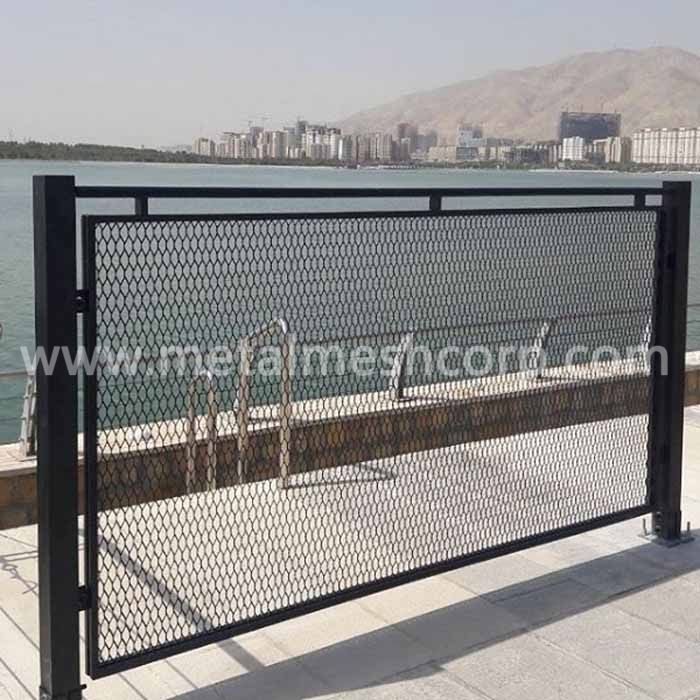For filtration methods that require strength, heat resistance, and durability, three forms of metal make up the vast majority of solutions that meet these requirements: perforated metal, expanded metal, and wire mesh. Each type provides effective filtering. However, each attribute and quality difference should be considered when determining which method is best for an application.
Below, we'll examine each type of solution and its properties.
Perforated Sheet Metal: Perforated metal is metal that has holes or openings punched out by means of an "all-around" press or other methods such as CNC stamping or laser cutting. Unique qualities of perforated metal for filtration or separation include:
Versatility: Of the three materials discussed here, perforated metal offers the greatest overall versatility in pattern, shape, material type, and hole size. When the open area (the "holes" that allow the passage of air, light, liquid, etc.) is critical to the efficient operation of the application, perforated metal provides the most control over the open area. Different punching tools and other cutting methods can be used to meet almost any desired hole or perforation configuration. Another important difference worth mentioning is that the perforation manufacturing process offers the flexibility to leave no holes in certain areas. For example, a portion of the solid surface may be a design requirement to prevent filtering in precise locations or to provide a solid mounting surface in a specific location.

Strength: While all three methods provide high structural strength, perforated metal is the only method that can stand alone. This is because perforated metal can create a "non-perforated" boundary on its outer edge, providing greater stability. Expanded mesh and wire mesh must be attached to the stabilizing frame. When added strength is required, metal can be perforated in a variety of materials and thicknesses, while other materials and thicknesses are limited. For example, perforated metal can be used for steel sheets up to 1 inch thick or stainless steel up to 1/4 inch thick.
Weight: Since the material is removed during manufacturing, perforated metal will weigh much less than expanded metal when using a comparison material. In addition, it has a great strength-to-weight ratio, which means a reduction in weight without a significant reduction in strength. This is an important distinction for weight-sensitive applications.
Aesthetic appeal: Perforated metal can have holes in a variety of hole sizes and shapes: circles, squares, diamonds, and other geometries with a high degree of sophistication. When design is as important as function, perforated metal is often the right choice.
Expanded metal mesh: Expanded metal mesh is produced by cutting a pattern of slits in a metal coil and then stretching (or "expanding") the slits into diamond-shaped holes. Due to the nature of the process, expanded metal is generally a thinner material than the other methods described here. However, this metal type offers many advantages and unique properties.
Configuration Options: While the unique diamond pattern of expanded metal cannot be changed, expanded metal sheets can be configured in different ways. Standard expanded metal retains the part's three-dimensional raised, slightly twisted configuration after the stretching process. The metal can be further processed to flatten any diamond lines that may be raised or slanted. Additionally, expanded metal can be cut into unique patterns for a more aesthetically pleasing look.
Strength: The one-piece construction, as well as the diamond-shaped configuration, provides a great deal of structural integrity. Therefore, expanded metal mesh is often used in industrial applications such as floors, steps, walls and gates.
Wire mesh: Wire mesh can be of woven (interlocked) or welded construction. In either case, the wire mesh is made of multiple strands of wire held together to form a mesh. Some of the unique properties of wire mesh include:
Flexibility: Wire mesh, sometimes called "silk cloth," is woven in a way that provides the same flexibility as cloth. For applications that require a non-rigid structure with the same filtration properties as metal, wire mesh is often the right choice.
Versatility in size and construction: Wire mesh can be manufactured with large openings (for applications such as fencing) or nearly invisible openings (when higher filtration rates are required). In addition, wire mesh offers some flexibility in the shape of openings, although there are not as many options as perforated metal.
Previous: ER110S-G / G69 4 M21 ZMn3NiMo Welding Wire Manufacturers
Next: Custom Magnet Coatings Rare Earth Magnet Suppliers Custom Coating Neodymium Magnets
Copyright:@2020-2021
Comments Please sign in or sign up to post.
0
0 of 500 characters used